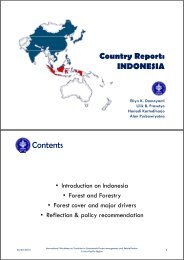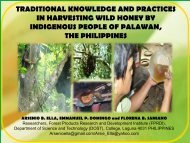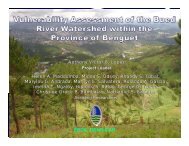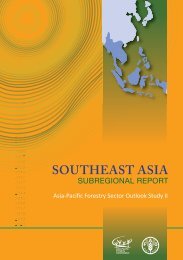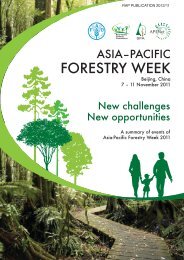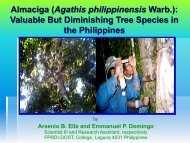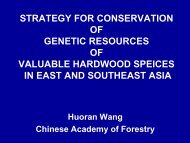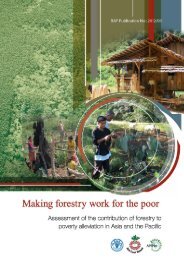conservation strategy of sandalwood resources in indonesia
conservation strategy of sandalwood resources in indonesia
conservation strategy of sandalwood resources in indonesia
- No tags were found...
Create successful ePaper yourself
Turn your PDF publications into a flip-book with our unique Google optimized e-Paper software.
CONSERVATION STRATEGY OF SANDALWOODRESOURCES IN INDONESIAAnto RimbawantoCentre for Forest Biotechnology and Tree ImprovementYogyakarta - Indonesia
BACKGROUNDNative to eastern IndonesiaEconomically important speciesfor west Timor (Nusa TenggaraTimur/NTT)Genetic <strong>resources</strong> aredisappear<strong>in</strong>g fastUrgent need for genetic<strong>conservation</strong> andrehabilitation/replant<strong>in</strong>g
Map <strong>of</strong> Santalum album generalized natural distribution <strong>in</strong>IndonesiaSouth Sulawesi, Moluccas Islands, Timorand eastern tip <strong>of</strong> Java
RESOURCESNatural populations ma<strong>in</strong>ly <strong>in</strong>west Timor are disappear<strong>in</strong>gfast. Dur<strong>in</strong>g the 10 yearsperiod from 1987 to 1997, thenumber <strong>of</strong> sandal trees <strong>in</strong>Timor dropped almost 50%from 544,952 trees to only250,940 trees.Plantation establishment ishampered by social/politicaland silvicultural issues
ECONOMIC IMPORTANCEImportant commodity for theProv<strong>in</strong>ce <strong>of</strong> NTT as it contributessignificantly to the local economy.Between 1986 and 1991,<strong>sandalwood</strong> contributed up to40% to the total <strong>in</strong>come <strong>of</strong> theProv<strong>in</strong>ceS<strong>in</strong>ce 1997 it has decl<strong>in</strong>edsteadily reach<strong>in</strong>g a low level <strong>of</strong>less than 5%
RISKSSlow grow<strong>in</strong>g speciesFormation <strong>of</strong> heartwood - themost valuable part <strong>of</strong> the tree - isslow and subject to genetic andenvironmental factorsSocial and physical conditions forplantation establishment arelack<strong>in</strong>g (fire, graz<strong>in</strong>g, silviculture)
OPPORTUNITIESEconomically important productsfor NTTSantalum album is the mostvaluable <strong>sandalwood</strong>Could help alleviat<strong>in</strong>g poverty <strong>in</strong>NTTCollaborative projects withneighbour<strong>in</strong>g countries such asAustralia and other countries <strong>in</strong>the Pacific
Genetic Diversity StudyCollection <strong>of</strong> 17 provenances (Timor-10, Sumba-3,Alor-3, Jawa-1)17 RAPD primers
OutputsGenetic diversity mostly resides with<strong>in</strong>population: 0.391 (with<strong>in</strong> population);0.038 (between population)Lack <strong>of</strong> association betweengeographic location and clustergroup<strong>in</strong>g
CONSERVATIONSTRATEGYStrategy 1Inventory <strong>of</strong> the rema<strong>in</strong><strong>in</strong>g <strong>sandalwood</strong> trees still exist <strong>in</strong> Timor islandsStrategy 2Ma<strong>in</strong>ta<strong>in</strong> exist<strong>in</strong>g <strong>sandalwood</strong> trees to protect the rema<strong>in</strong><strong>in</strong>g genetic<strong>resources</strong> and to prevent further loss <strong>of</strong> genetic diversityStrategy 3Collect seeds from the exist<strong>in</strong>g trees found across Timor islands andestablish ex-situ <strong>conservation</strong> plots <strong>in</strong> several locations as well as foroperational plantation
CONSERVATION STRATEGYStrategy 4Plant<strong>in</strong>g program for rehabilitation <strong>of</strong> natural stands aswell as for commercial production <strong>of</strong> <strong>sandalwood</strong> shouldbe cont<strong>in</strong>uedStrategy 5Cont<strong>in</strong>ue research on <strong>sandalwood</strong> necessary for thedevelopment <strong>of</strong> a scientifically based <strong>conservation</strong><strong>strategy</strong>
Thank you




